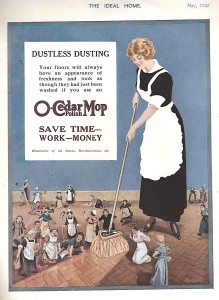 In the current issue of the TLS Nicholson Baker reviews what was being published a hundred years ago. In this Jot we look at what was happening in the world of home appliances and gracious living, according to the May 1920 issue of The Ideal Home.
In the current issue of the TLS Nicholson Baker reviews what was being published a hundred years ago. In this Jot we look at what was happening in the world of home appliances and gracious living, according to the May 1920 issue of The Ideal Home.
As always, it’s the adverts that entertain the most. The first that greets the reader is a full page colour ad for the O-Cedar Polish Mop which shows twenty or more tiny maidservants admiring the wonderful effects produced by a giant charlady manoeuvring this mop around a giant room. It makes one wonder how many middle-class supporters of the Women’s Suffrage movement employed female cleaners in their large, comfortable houses. Quite a few, one would have thought.
In contrast, on the following page we have an advert meant, we presume, for male readers, who are urged to save on average £30 by buying a machine designed to make concrete roofing tiles ‘ on the site’.
Mains electricity for lighting and power was patchy in this immediate post-war period and relied on local council-run generating stations. An Act of 1919 gave the go-ahead for a more nationwide supply system, but this wasn’t established until the National Grid came into being in 1935( remember that poem ‘ Pylons’ by Spender ?). For those who afford it in 1920, a petrol driven domestic generator was one source of electricity. Home owners would hide away their generator, in this case a ‘ Delco-Light ‘ available from F. S. Bennett of Oxford Street, in a shed or outhouse to minimize the noise and fumes produced by it. With one flick of a switch by ‘a maid or boy’, the machine would come to life and there would be instant light and power for every electrical appliance. It’s a pity that so few (if any) works of literature in this early modernist period in Britain feature examples of such an important source of electricity (‘ Home appliances in the works of Virginia Woolf’, anyone ? One writer, who in his memoirs did recall an electrical apparatus being operated in his Kent prep school by its headmaster, the paedophile ‘ Gomez’, from 1911 to 1915, was the poet Geoffrey Grigson. It is unlikely that when he returned to his family home in Cornwall for the holidays Grigson would have found that his Vicar father had bought one of these new-fangled generators. Oil lamps were still the favoured source of illumination in rural communities, although an advert on page 18 of the magazine suggests that some households might have had acetylene lighting installed instead. ‘Spectrum analysis prove it second only to sunlight’, was the boast of Thorne and Hoddle of Victoria Street, London.
And lest we forget, if you lived in the country in 1920, particularly away from the main conurbations, say in Cornwall, Norfolk, Cumberland or Northumberland, let along the Highlands of Scotland, you are not likely to enjoy running water. Some cities began to have running water from the eighteenth century, but even in the twentieth many villages with a low water table were dependant on deep wells. I know of one particular community in North Herts that didn’t have piped water until the nineteen sixties !
But the TBS Electrical Construction Company of Victoria Street, Westminster had the solution to all your domestic water woes in the shape of The Dayton Automatic Pressure System. Here’s some of the advert:
‘…”A woman’s work is never done”. From early morning until late at night—the woman of the house is on her feet all the time.
She begins the day by lugging the water pail out to the well—so that she can make the breakfast coffee. And from then on it is just one trip after another. Water for washing dishes, water for cooking, water for drinking…
You can take this big load off her shoulders, and can make her house-keeping pleasant and easy by installing a Dayton Automatic Pressure System in your home. With this automatic system you can have running water in the house—from the kitchen to the bathroom—you can save her all those trips to the well…’
[R.M.Healey] To be continued..
.
